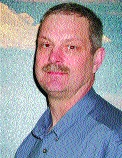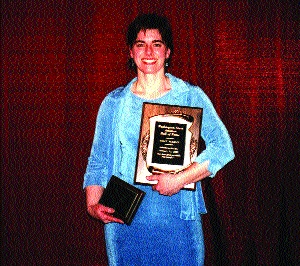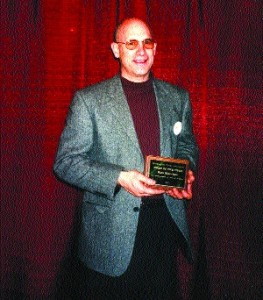By Deborah Hopen

Rick Luke, Recent Washington Aviation Hall of Fame inductee, was recognized for his easy-going manner and exceptional communication skills as a flight instructor and his reputation as a thorough, fair examiner.
The Washington Aviation Association sponsored another successful conference and trade show February 22-23. Over 10,800 aviation enthusiasts attended the organization’s 20th annual Northwest Aviation Conference and Trade Show, held at the Western Washington Fairgrounds in Puyallup, Wash.
Both presenters and exhibitors shared in celebrating the 100th anniversary of powered flight, showing photographs and videos and telling stories of the Wright Brothers’ famous flight at Kitty Hawk, N.C. It was easy for attendees to grasp just how far aviation has come since 1903, as they saw the latest developments in avionics and aeronautics, learned more about what’s happening in general aviation, listened to the perspectives of the speakers, and even explored the frontiers of flight by visiting the NASA exhibit.
Mark Grady, writer, commercial pilot and professional speaker, kicked off the presentations and provided the banquet address. On Saturday morning, he shared humorous insights on how real life affects flying habits in “Why Did I Do That?” His lighthearted views reflect his varied experience, including 10 years as a radio traffic watch pilot. During the evening’s Hall of Fame banquet, Grady shared the perils of being a “vertically challenged” pilot in his speech, “Flying Friendly.” When he shared his idea of getting the FAA to authorize telephone books as “pilot height extension devices,” everyone in the audience got to experience his unique sense of humor.
The afternoon presentations began with an update on the current state of aviation by Phil Boyer, president of the Aircraft Owners and Pilots Association. Boyer shared that this was the twelfth year in a row he had attended the conference and that he felt it was “the premier event of its kind,” providing the strongest program and having the highest attendance.
Every pilot recognizes the need to keep abreast of changes to the requirements for FAA medical certification. Dr. Henry Boren, one of five medical officers who work for Dr. Silberman of the Aviation Division at the National Aerospace Medical Headquarters in Oklahoma City, Okla., not only shared information on the latest requirements but also delved into the issuance of special certificates for pilots with medical challenges.
Julie Clark, who recently was inducted into the Women in Aviation, International Pioneer Hall of Fame, spoke on “American Aerobatics Mopar T34.” Clark is a veteran pilot of 25 years with over 25,000 accident-free hours. In addition to being the first woman to fly for a major airline and currently serving as a captain for Northwest Airline, she is checked out in more than 65 types of aircraft, including B-17s and PBY-5 flying boats.
Clark told the story of her sight-unseen purchase of a T-34 for $18,000 in 1977, and its restoration, as well has the joys and challenges of flying in over 20 air shows a year. An often-recognized air show pilot, she is known for her graceful aerial ballet.
Bruce McAllister led off Sunday’s speaker line-up by showing photos from his book, “Wings above the Arctic: A Photographic History of Arctic Aviation.” Although McAllister resides in the Colorado Rockies, he has traveled throughout the Alaskan Acrtic, the Northwest Territories, the Yukon and the Alaska Highway. He displayed slides from his travels and shared some of his more exciting adventures.
Then attendees got to hear the tale of how Molly Peebles turned a dream into reality when she discussed the Flight Across America. As a new pilot, Peebles was disgusted that aircraft were used as weapons of mass murder during the 9/11 terrorist attacks. She combined her compassion for the victims with her convictions about Americans’ right to fly and conceived the now-famous flight. Peter Bowers, noted aviation historian, discussed “100 Years of Powered Flight.” In addition to providing his views from a 36-year career in aeronautical engineering at Boeing, Bowers also shared from his extensive collection of aviation prints and negatives.
The conference presentations concluded with Erik Lindbergh’s recounting of his May 2002 recreation of his grandfather’s historic 1927 flight across the Atlantic. He flew from San Diego to St. Louis to New York to Paris, accomplishing the 3,600-mile transatlantic portion in 17 hours, seven minutes. Although it’s clear that Charles Lindbergh faced different challenges during his landmark flight, Lindbergh’s trip was not without its difficulties. Weather conditions forced him to vary his altitudes from 7,000 to 17,000 feet, and fatigue was his constant companion. Additionally, Lindbergh went through a strenuous pre-flight survival training program that was particularly taxing for him because he suffers from severe rheumatoid arthritis, a progressive autoimmune disease marked by pain, tenderness and inflammation of the joints. Lindbergh commented that several airliners in the area and his New Spirit of St. Louis Mission Control Team offered encouragement and boosted his morale throughout the trip.
Over 120 exhibitors filled two halls with their displays and demonstrations. Attendees had the opportunity to test the newest version of Microsoft’s Flight Simulator Professional Edition; check out instruments, airplane equipment, and associated gear; learn more about local fields and general aviation services; and to plan fly-ins to remote resorts.
EAA Chapter 326 teamed with The Museum of Flight to present the 1st Annual Up Up ‘n Away Kids Avfair, which included a discussion of the basics of flight, hands-on activities, and The Flying Gizmo Show, as well as the Paper Airplane Fly-off.

Molly Peebles was inducted into the Washington Aviation Hall of Fame for her work with the Flight Across America.
Numerous not-for-profit and governmental agencies also distributed information and answered questions for attendees.
The Fifth Annual Hall of Fame Awards Banquet was the Saturday evening highlight. John Sibold, aviation director of the Washington State Department of Transportation, announced the four 2003 inductees.
“An aviation community is built on individual contributors and grass-roots efforts,” Sibold commented. He noted that the Hall of Fame recognizes significant contributors, saying, “Aviation is the American dream—a dream for people who love their country and love freedom.”
First, Rick Luke, CFI, CFII, MEI and FAA designated pilot examiner at the Bellingham International Airport, was recognized for his easy-going manner and exceptional communication skills as a flight instructor and his reputation as a thorough, fair examiner. Luke began to fly in 1971, purchasing a Cessna 150 and taking his commercial check ride in 1974. He has a single-engine sea rating at the commercial level, as well as instrument and ATP in both single- and multi-engine. He also holds advanced and instrument ground instructor ratings and is a master instructor with the National Association of Flight Instructors.
James Scott (1933-1996) was recognized posthumously. Scott was a founding father of ultralight aviation and a founder of the ultralight airpark at Arlington Airport. He obtained his private pilots license when he was 32, and he owned and flew a variety of aircraft over the next 20 years.
After losing his medical certification in 1982, he took up ultralights and sport aviation. During his life, Scott was awarded the WAA Major Achievement Award in 1989, the Top Gun Award in 1991, the Hendricks/Beckwith Memorial Award and the Lifetime Friend of the Northwest EAA Fly-in Award. He was also recognized by the Seattle Flight Standards District Office and received a certificate of appreciation from the Federal Aviation Administration for his contribution to the Advisory Circular 90-89A Amateur Built Aircraft and Ultralight Flight Testing handbook.

James Scott, inducted into the Washington Aviation Hall of Fame posthumously, was a founding father of ultralight aviation and a founder of the ultralight airpark at Arlington Airport.
Keith McCaw (1954-2003) also was named posthumously to the Hall of Fame. McCaw demonstrated his personal love of aviation by being a longtime supporter of programs for children at The Museum of Flight. He was keenly interested in new developments in the aviation industry, and he owned several airplanes and was a licensed pilot. McCaw believed that aviation was a way to make the world more accessible to all people and that it increased children’s interest in science, math and technology. He supported the museum with his leadership, financial contributions and the use of his aircraft.
Molly Peebles was named for her work with the Flight Across America. Peebles showed how to break away from self-imposed limits and accomplish incredible results by employing a can-do attitude and collaborative approach. Her leadership brought pilots from over 15,000 airports across the U.S. together, transforming tragedy into a unifying process of healing.
Stan Allison of the Washington State Department of Transportation then presented their annual awards. Quillayute Airport, at the tip of the Kitsap Peninsula, a former military base that was decommissioned in 1945, was recognized for its incredible rejuvenation since the City of Forks took over its management from the Washington State Department of Transportation in 1999.
Rod Fleck led the project for the city, completing the turnaround on time and under budget. Paul Bennett, director of public works for Kittitas County, was named Airport Manager of the Year for his leadership at Bowers Field in Ellensburg.
Harold Hansen received the Volunteer of the Year Award for his work at Concrete Airport, where he has integrated his efforts creating a beautiful and fully serviced facility with hours spent at the adjacent high school to create a community-based aviation program for current and future generations.
The Washington Pilots Association also announced that Kirk Kleinholz had been named Pilot of the Year and that Molly Peebles had received the Harold Wilson Memorial Award.
Rachel Hanson, executive director of WAA, deserves much credit for coordinating the development and conducting another successful conference and trade show.












